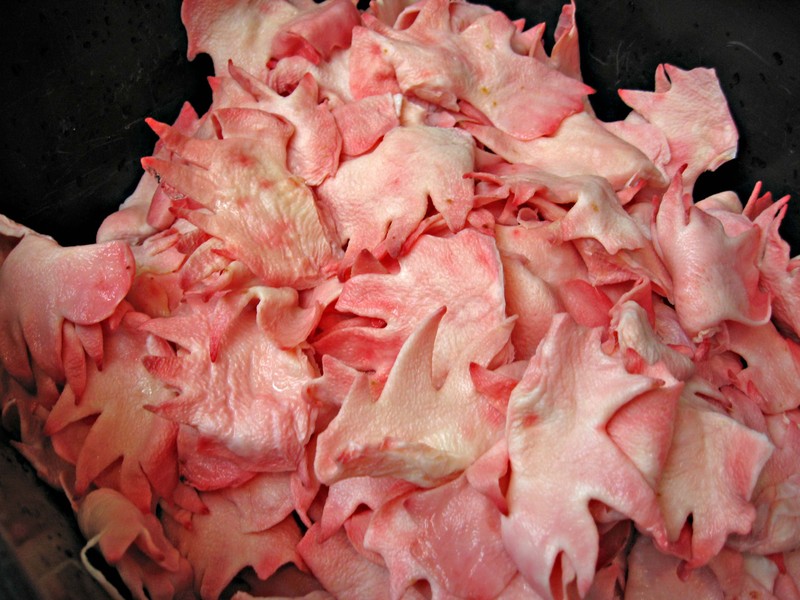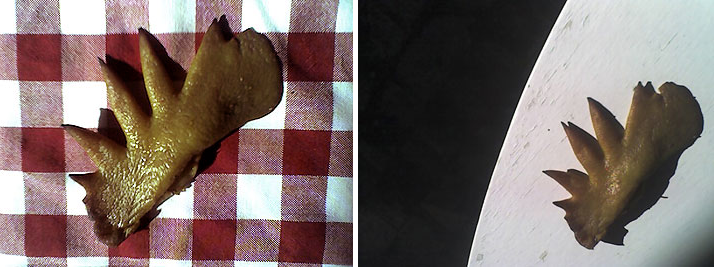
Raw rooster combs. From Ideas in Food: The Great Cock's Comb Adventure.
The American writer Calvin Trillin used to tell a story about one of his daughters who, upon being invited one day to accompany her father to a new restaurant, inquired meekly if it would be all right if she "took a bagel just in case." This tale was repeated to me frequently as a child, as this was the role I played in my family: I was the worrier, the apprehensive and non-adventurous one, the child always wary of novelty — especially if it meant eating something weird.
As it happened, I married the opposite personality type — someone who, on a recent trip to Spain, did what he always does when we travel: he went native.
And then he ordered rooster comb.

Sautéed Rooster Comb. (Day 1, left. Day 5, right.) 2007.
Rooster comb is a Catalan delicacy, and has been compared to chicken feet: it's flaccid and tan-colored, with diaphanous skin and a wobbly texture. Poke it with your fork, and it has the consistency of fatty flesh: it's rubbery, like the glove the evil penguin wore on his head in The Wrong Trousers. Bizarre, but then again, eating is often a springboard for such associations, which helps to recast the whole idea of food as entertainment. (Which in turn leads to things like Iron Chefs and extreme cakes.) Like breathing and sleeping, we eat to live. It's hard to imagine a television program about the dramatic highs and lows of oxygen intake, but food is something else altogether.
Where food is concerned, the relationship between what things look like and how we respond exists at its most primal level: what is a gut reaction, after all, if not something that attacks your gut? Food preferences are personal, idiosyncratic, and odd. They're also framed by things like appetites, religious preferences and allergies; swayed by things seasonal, products regional, and palettes likely to be unpredictably mercurial. And no matter what it is or how picky we are (or aren't) — the fact remains that what food looks like has a huge bearing on what we taste.
Personally, where anthropomorphic meets edible is where I draw the line.
And while there was perhaps something eerily beautiful about that floating, disenfranchised fan of rooster muscle — beautiful, that is, in the most abstract way possible — I couldn't get past its unsettling resemblance to Foghorn Leghorn. (I am sure that the sandwich spread known as Goober's is just as horrifying to most people, but it doesn't look like a body part.) The fact that this curious delectation was ordered as a side dish for a meal consisting of foie gras and octopus is enough to make even the most intrepid epicure reconsider the virtues of a vegan diet.
Of course, the discussion and visual documentation of weird food is something well-represented by a host of websites maintained by foodies and the people who love them: from 1970s Weight Watcher's Recipe Cards (thank you, Bethany Johns) to Musk-Flavored Life Savers, here's a sure-fire way to drop those extra pounds. Then again, who am I to disparage rooster as a menu item? Alaina Browne praises a New York restaurant that offers up this dish "braised to gummy brownness," while critic Andrew Zimmern describes them here as a "gelatinous delight."
This summer has dawned with a host of food-related films, from Ratatouille to No Reservations the pink dougnut of an "O' in The Simpson's Movie logo, reminding us that audiences don't only like to eat food, they like to look at it, too: in cookbooks and on television, in magazines and in retail establishments, in markets and on restaurant tables all over the planet. Which, in the global world of anything-goes culinary inclusivism, just happens to include rooster comb. Mercifully for the less adverturesome among us, it also includes bagels.
For more on the intersection of design + food, pick up a copy of The Quarterly, Volume 1, Number 3: The Food Issue.
This essay was originally published in July, 2007.
